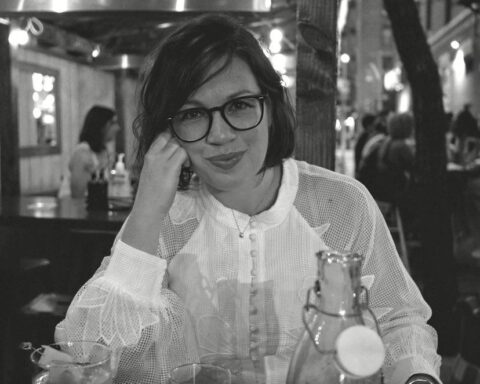Let’s start at the beginning. In flash, titles hold weight for their literal and/or metaphorical connotations. Here, “Pepper Sauce” plays a significant narrative role, the cough it induces breaking the trio apart long enough for tension to build: atop tears, atop apologies, atop an important question that is foreshadowed but never answered. What was your guiding principle in choosing this story’s title?
The honest answer is Kyle Sahadeo (my husband) was/is my guiding principle. In this particular case, I handed the story to him and asked, “What would you call this?” I’m a person who usually begins with a title, which is often the first joke of the piece. But sometimes a title like that is my way of avoiding accusations of sentimentality. This story is sentimental over the sentimental, so I tried not to hide that.
An even more honest answer is my life can be divided into two distinct sections: before Bertie’s Pepper Sauce and after Bertie’s Pepper Sauce. Kyle is from Trinidad, and he introduced me to it (brighter and limier than hot sauce) when we started dating. Now, nothing feels complete without it: gyros, biscuits, sloppy burritos. I don’t remember not knowing the taste in the same way I don’t remember not knowing his voice.
“We value each other’s opinion above any other metric for compatibility” conveys so much about the depth of their old bond. It also colors the question—What do you think about him?—with a palpable anxiety. Why is it important that this question is never outrightly answered? How do you evaluate the power of things left unsaid in storytelling?
There’s a certain magic to friendships formed in your late teens and twenties, a time when no one is expected to take precedence over your friends. These relationships are so fundamental to forming who we are (and how we love), but they’re also fragile because there’s no institutional glue holding them together.
The question comes at a particularly fragile moment in this friendship. There’s distance between them, and it’s an invitation to return to the kind of intimacy they shared when every relationship was dissected over diner coffee. But it also represents the possibility of destruction.
I’m brave enough to ask the question but not to hear the answer. Without an answer, I can dwell in the delicious possibility of reconciliation. That’s the power (and the problem) with things left unsaid.
In a piece full of lovely lines, I especially liked “stacks of cocktail napkins accumulate at our elbows.” This vivid image functions as a friendship motif, helping to anchor their shared history in the reader’s memory. What other uncommon motifs show up in your real-life bonds?
No relationship is complete without scraps of paper saved in drawers meant for overflow condiments (ticket stubs, lipstick blot receipts, index card cartoons). Polaroid photos are another favorite. They rarely come out the way you (I) plan them, so every shot that survives is a little celluloid miracle.
I’m particularly curious about the contrasts between old vs. new modifiers attached to “friend” and “husband,” which on some level seems to hint at familiarity and comfort. The Waffle House rituals situate the friend as familiar, but there’s also the alienness of her watching how the couple eats their roti before diving into hers (which I found quite touching in its relatability, by the way). What informs the deliberate consistency of the “old best friend” and “new husband” descriptors? What is gained in their repetition or lost in their absence?
The symmetry of “old best friend” and “new husband” implies one will replace the other. But that’s intentionally misleading, and the repetition is meant to make this even more confounding, both for the narrator and the reader. The story would like you to think this is a binary choice between the “old best friend” and the “new husband” when, in reality, it (the narrator? I?) would like you to consider the possibility that this is a false choice. Without these titles, the story loses the question at its heart: can I love my best friend the same way I did before I met my husband?
Let us float to the very end. There’s a poignancy to the relaxed smile at the unyielding stain, how this lighter place is where we leave the characters. Did you always know this was where this story needed to end?
No. It’s difficult to know where to end things because you want to underline some kind of wisdom you’ve uncovered (even in this answer, I find myself wanting to poke around until I hit something profound). But honestly, the stain felt self-evident. It’s as bright and yellow as the Waffle House sign.



 The SmokeLong Grand Micro Contest (The Mikey) is now an annual competition celebrating and compensating the best micro fiction and nonfiction online.
The SmokeLong Grand Micro Contest (The Mikey) is now an annual competition celebrating and compensating the best micro fiction and nonfiction online.